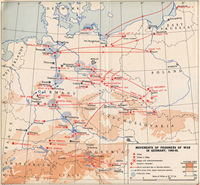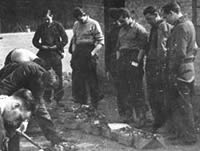Prisoners of War
Map showing movements of POWs in Germany, 1944–45
POWs divide up the swede peelings from the German mess
Forced Marches
As the war drew to a close, POWs in the more eastern of the German camps were often gathered together at short notice and marched off under guard in a westerly direction—away from the approaching Russian army. Others were sent by train.
This was a time of great hardship. It was winter, the men were not in good physical condition, supplies of food were erratic and sparse, the guards were touchy and often seemed not to know where they were supposed to be going. An added danger was the planes of the Allied air forces which roamed the skies at this time, bombing traffic movements and towns and cities.
Many of the marches were hundreds of kilometres long. Here you can read a diary of one POW to gain some idea of the experience.
At the end though, most New Zealand POWs were liberated by either British or United States troops. It was an exhilarating experience for some—for others it seemed almost a letdown. But, the war was over and soon they were on their way back to the repatriation centre set up by the New Zealand defence force in Kent in England and then, before too much time had elapsed, they were sailing back to New Zealand.
Norman Jardine's diary of a forced march
Norman Jardine served with the 6th Field Ambulance and was taken prisoner after missing out on being evacuated from Crete in May 1941. He was taken firstly to Salonika in Greece and later to 8B Lamsdorf and 8A - E 749 (Ratibor). Norman sent in these 'highlights' of his forced march from Jan 1945–May 1945; 14 weeks in which the POWs walked 962 km. His march ended near Munich.
20/1/45 Action on the Eastern Front drawing nearer, Russian planes over, noise of gunfire etc, civilian refugees now streaming past. Reserve store open, I got a pair of new boots and all got a food parcel.
22/1/45 Camp abandoned, 1-30p.m. (In South-west Poland)
25/1/45 Made ourselves a sledge to tow packs through snow, lasted 2 weeks.
28/1/45 First 'rest-day'. Hot water available
29/1/45 Last bread issue.
4/2/45 First hot soup issue
6/2/45 Stopped moving for five days (road congestion)
24/2/45 Sold my wristwatch for 10kg green bread — shared of course! Seeing large flights of U.S. planes
2/3/45 A cold snap, winds and snow again
10/3/45 Heard (B.B.C. news). Red Cross food parcels en route. (Arrived next day — Surprise!)
30/3/45 Good Friday. Indeed good — got a parcel and card to send home. (Not surprisingly, never arrived). Now halted for three weeks, near a P.O.W. camp, very crowded but rations improved.
16/4/45 Back in the war! U.S. planes over, attacking our guards.
24/4/45 Crossed the Danube. Passed a column of political prisoners, "Walking matchsticks" — shot as they fell out.
26/4/45 Now going in "ever decreasing circles" German troops resting and trying to move east.
29/4/45 At 6p.m. told we would be handed over to the U.S. army very soon.
1/5/45 U.S. tanks appeared over a hill. Freedom at last!. Our guards disappeared smartly but were all rounded up. A U.S. officer handed over a revolver, told us to shoot any who had treated us "unfairly" (We did!) We looked for billets in the nearby village, best night in years. Issued with U.S. white bread (cake to me!)
Next: Tiki Times >

